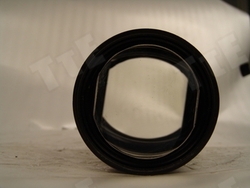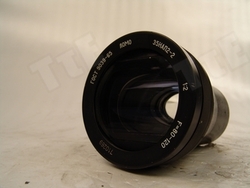Screening
Return
LOMO cinemascope anamorphic lens
The Greek etymology of the term ‘anamorphic’ means ‘new-form’. In optics, it refers to any lens that enlarges both the vertical and horizontal axes of an image. In cinema it refers to the lenses that compress the horizontal axis of an image up to half its size in order to ‘fit’ in the width of the frame– when used during shooting, as well as for lenses that decompress the same image during projection, so that the image appears normal on the screen. With this technique the result is a ‘wide-screen’ image. The ‘cinemascope’ system was introduced by 20th Century Fox in 1953 in the film ‘The Robe’, directed by Henry Koster. Based on the system by Henri Chrétien (see artifact ‘11’), the lens that ‘Fox developed compressed the width of the image with analogous decompression during projection, initially resulting in 2.55:1 width to height, and then 2.35:1 for the soundtrack to fit. This specific exhibit is a projector lens of Russian manufacture from the ‘60s.






